Splashdown in the Firth of Forth: The crash of Loganair flight 670A

On the 27th of February 2001, a Scottish cargo plane lost power in both engines shortly after takeoff from Edinburgh. With only seconds to find a landing spot, the pilots faced a stark truth: they weren’t going to make it back to shore. Loganair flight 670A came down in the waters of the Firth of Forth and broke into two pieces, driving the cockpit underwater before the crew had any chance to escape. Both pilots drowned in the freezing waters of the North Sea, leaving only the black boxes to explain what went wrong with their plane.
The data showed a confounding sequence of events: the engines were working perfectly, right up until the first officer turned on the engine anti-icing vanes, at which point both engines flamed out simultaneously. Examinations showed there was nothing mechanically wrong with either engine. So how could they have failed? It would take a detailed analysis of the design of the engines, the weather conditions on the ground before the flight, and the way the airline operated its planes before the answer started to come together.

Loganair is the largest regional airline in the United Kingdom, operating scheduled passenger and cargo flights to, from, and within Scotland using its fleet of more than 40 small aircraft. Loganair has always operated a wide variety of aircraft types, and still does today. In 2001, one of the more esoteric models in its fleet was the Short 360, a 39-seat twin turboprop manufactured by Short Brothers aerospace company in Northern Ireland in the 1980s. Short Brothers (also known as Shorts) was founded in 1908 and was the first company to manufacture and sell production aircraft. (It still exists today as Thales Air Defense Systems, which mainly manufactures missiles.) By the 1980s it was still alive and kicking, continuing to produce smaller aircraft, mainly turboprops. The Short 360 was derived from the 1962 Short SC.7 Skyvan, an extremely square 19-seat twin turboprop known affectionately, or maybe derisively, as the Flying Shoebox. The Skyvan later evolved into the Short 330, a 30-passenger variant that was only slightly less boxy. Some pilots jokingly referred to it as “the Shed.” The Short 360, the aircraft operated by Loganair, was essentially a stretched version of the 330 with a redesigned tail, and was the first model in the line to look vaguely like a real airplane. It still had some of that distinctive boxcar look, however, thanks to its rectangular fuselage cross-section and its unusual roof-mounted fuel tanks.

Loganair had converted its Short 360s to cargo planes by removing the passenger seats and cabin amenities. The square fuselage made the type ideal for cargo because storage space could be more effectively utilized than on other similarly-sized planes. And so it was that a modified Short 360 arrived at Edinburgh Airport three minutes after midnight on the 27th of February 2001, ready for a quick turnaround and a new crew to fly it to Belfast, Northern Ireland. The charter flight on behalf of the Royal Mail was supposed to leave at 00:40, but events soon forced a change of plans.
That night, weather conditions in Edinburgh were unusually bad. A 36-knot wind out of the north carried with it freezing temperatures and light falling snow, which billowed across the landscape and piled into drifts. After parking the plane at the ramp just after midnight, the crew of the inbound flight closed it up and went home, while the next crew arrived at the airport to take the plane on to Belfast. When they reached the plane, they found that it would need to be de-iced before it could fly, but they were advised that de-icing equipment was unavailable at that time and likely would not become available for several more hours. Expecting to take off later that night, this second crew went back to the break room to wait for the de-icing equipment.

But at 2:10 a.m., it was announced that the airport was closed due to severe weather, without any clear picture of when it would reopen. By 6:00, the pilots were advised that the airport would not reopen in time for them to complete the flight within duty time limits, so they went out to the plane and prepared it for a longer period parked on the ramp. Working off of official procedures, they fixed the propellers in place with propeller stops and placed covers over the pitot tubes. The procedure also called for bungs to be placed over the engine air intakes to protect them from blowing snow, but there weren’t any engine intake bungs available at Edinburgh Airport. The airline normally returned its planes to Inverness, Kirkwall, and Glasgow at night, so the bungs were kept there; Edinburgh was only supposed to be an en route stopover. As a result, the crew had no choice but to leave the plane parked without any engine air intake bungs in place before going off duty.
By 9:52 a.m., the snow had stopped falling and the wind began to die down. The airline now began working out how to get the plane to its destination in Belfast. Another flight crew, consisting of 58-year-old Captain Carl Mason and 29-year-old First Officer Russell Dixon, had originally been scheduled to fly a different flight from Glasgow to Islay at 9:10, but that flight was cancelled due to bad weather, so Loganair assigned them to finish the Edinburgh-Belfast flight instead. It proved impossible to get from Glasgow to Edinburgh by car due to the road conditions, so the crew had to wait for Edinburgh Airport to reopen in order to hitch a ride there on another company plane. The airport finally did reopen at 11:30, and the crew arrived there an hour or two later. The crew went immediately to the aircraft, but what they did while there is not known, and they didn’t request clearance to start their engines until 15:03.
But the delays weren’t over yet. The left engine’s electrical generator wouldn’t come online, so the crew had to wait for a Loganair engineer to arrive at the airport and help them troubleshoot. Once he arrived, they were unable to reproduce the problem. Instead, the engineer checked the plane for ice and snow, saw none, and called them good to go. Mason and Dixon finally requested taxi clearance at 17:10, and flight 670A to Belfast at last pushed back from the gate, more than 16 hours behind schedule.
In fact, the seeds of the disaster which followed had already been planted. The plane had been sitting in an open area pointed directly into the wind for 17 hours, including 10 during which it was exposed to blowing snow. Over time, this snow accumulated inside the engine air intakes, which were left open due to the lack of bungs at Edinburgh Airport.
The Short 360’s two Pratt & Whitney PT6A-67R turboprop engines have an unusual “reverse flow” design. Air enters the engine through an intake at the front, but is then ported through a duct to the back of the engine, where it enters a plenum chamber from which air is distributed to the reverse-flow combustion chamber. The plenum chamber surrounds the aft part of the engine on the outside. When high winds blew snow in through the open air intakes, this snow was carried through the duct, around a 90-degree bend, and up into the top of the plenum chamber, where it accumulated over several hours. This snow would have been impossible to see even if the pilots had closely inspected the engine air intakes, which in any case was not part of the pre-flight inspection.
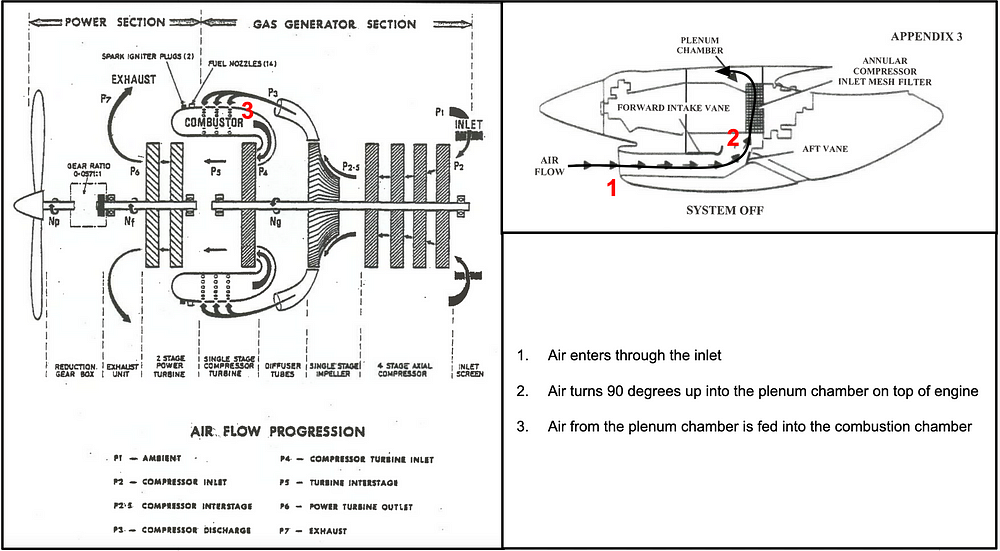
When the crew turned on the engines repeatedly during the period between 15:00 and 17:00, the snow inside the top of each plenum chamber began to melt and turn to slush, causing it to slide back down into the bottom of the 90-degree bend in the intake duct. Here it was again exposed to a blast of near-freezing air coming in through the inlet, causing the slushy mess to partially refreeze.
To understand what happened next, a brief description of the engine anti-icing system is needed. When flying in areas of icy precipitation, bits of snow and ice can enter through the air intake and fly up into the plenum chamber, where they can clog the entrance to the combustion chamber and cause the engines to fail. To prevent this, the pilots can engage the engine anti-icing system, which activates a pair of vanes located near the 90-degree bend in the intake duct. The forward vane opens downward until it blocks about 50% of the duct. Meanwhile, the aft (bypass) vane opens upward past the forward vane, turning the 90-degree bend into an S-curve, and simultaneously opening a bypass duct at the base of the curve. Air will continue to be sucked around the S-curve, but heavier particles of ice and snow, which have greater inertia, will be forced out through the bypass duct under their own momentum (see diagram below).
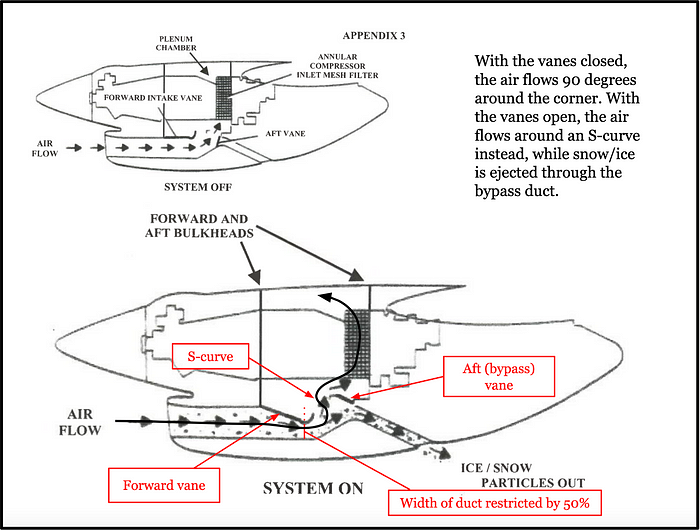
After sliding down from the top of the plenum chamber, the re-frozen slush formed a pile directly in front of the bypass vane. The bypass vane briefly opened during the pre-flight checks when the pilots tested several engine systems; when this occurred, it pushed the pile of slush forward and out of the way. But by the time the plane taxied to the runway for takeoff, the airflow through the inlet had pushed the slush right back to its original position again.
Unaware that there was ice inside the engines, Captain Mason and First Officer Dixon accelerated to takeoff power and rumbled off down the runway. Flight 670A lifted off beneath a partially overcast sky, climbing away normally over the Firth of Forth. Just in case there was snow stuck to the landing gear, the pilots cycled the gear twice during the climb to remove it.
As they proceeded through the after takeoff checklist, they arrived at a step which called for them to turn on the stall warning heaters. (The Short 360 has mechanical stall detectors on the wings which must be heated to prevent them from freezing.) Captain Mason decided that it would be prudent to turn on all the anti-icing systems, since he expected to encounter icing conditions once they entered the clouds. After switching frequencies to contact Scotland area control, First Officer Dixon proceeded to turn on the anti-ice systems, including the engine anti-ice vanes, as his captain had requested.

When Dixon flipped the switches to turn on the vanes, the bypass vanes again pushed the piles of slush forward as they swung open. This caused the slush to move into the area where the width of the duct was already being restricted by the forward vane. Normally the forward vane restricts the width of the duct by 50%, but with the additional presence of slush, the width was actually reduced by 75% or more. This triggered an abrupt decrease in airflow through the plenum chamber and into the combustion chamber, resulting in a near immediate engine flameout as the lack of air caused combustion to cease.

All the pilots knew was that First Officer Dixon had flipped the engine anti-ice switches, and then four seconds later both engines quit simultaneously. Captain Mason heard a reduction in engine noise and saw several warnings appear, and his first thought was apparently that his inexperienced first officer had done something wrong. But when asked what he had done, First Officer Dixon exclaimed, “Nothing!”
At this point, Captain Mason realized that both engines had failed and they needed to take immediate action. He began a right turn back toward the airport, while First Officer Dixon contacted air traffic control and said, “Mayday, mayday, mayday, this is Logan six seven zero alpha, we’ve had a double engine failure, repeat, a double engine failure!”
By now the plane had reached a maximum height of 2,600 feet above sea level before slipping into a descent. At this rate they would have less than one minute before they hit the ground — not enough time to run through the engine relight checklist. Captain Mason’s immediate and only concern was to find a place to put the plane down. He quickly realized that he couldn’t turn back to the runway: if he did, he would end up flying toward rising terrain with a strong tailwind. He needed someplace to make a forced landing, but at this point the plane was over the water, and the nearby shoreline was covered with trees, buildings, and hills. The only conceivable landing spot lay just a few kilometers ahead, a 500-meter long strip of grass in a public park running parallel to the shore. Turning onto a heading of 110 degrees, he aimed for the grassy field and prayed that they would make it.

As the plane descended, the ground proximity warning system blared, “SINK RATE! SINK RATE!”
The controller cleared the flight to a heading of 250 degrees to head back to the airport, but the crew ignored him.
“TERRAIN, TERRAIN,” said the ground proximity warning system. “WHOOP WHOOP, PULL UP! WHOOP WHOOP, PULL UP!”
Captain Mason fought to rein in their speed and descent rate, flying the plane on the hairy edge of a stall in an attempt to eke out as much distance as possible. Still descending at around 2,800 feet per minute, he pitched the nose up to extend the glide as their airspeed dropped below 100 knots. It suddenly became clear that they weren’t going to make it. First Officer Dixon tried to announce to air traffic control that they were ditching in the Firth of Forth, but a hill blocked his transmission and ATC never heard it.
At the last moment, Captain Mason pitched up to nearly seven degrees, the most he could manage, in the process reducing their speed to a mere 86 knots. It was the best ditching configuration he was going to get. Seconds later, flight 670A slammed into the heaving waves just 65 meters from shore, striking a swell with such force that the plane broke in two. The forward fuselage section pitched over, swan-dived six meters straight into the muddy sea bottom, and did not resurface.
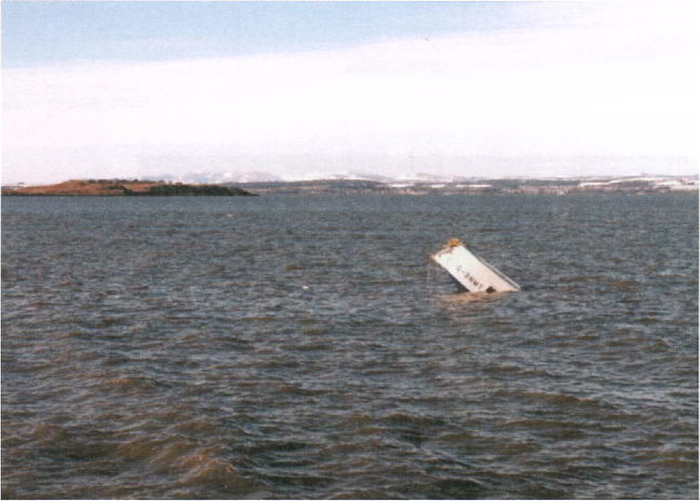
Although rescuers rushed to the scene of the crash to search for the crew, by the time they managed to launch a boat and reach the wreckage, it was clear that neither pilot had survived. The water temperature was very cold, around 6–8˚C, sufficient to cause cold shock upon immersion. Most likely, both pilots lost their ability to hold their breath on contact with the freezing water and drowned before they could attempt to open the escape hatch in the cockpit ceiling. Investigators would later note that in a previous ditching involving the Short 360, the pilots had deviated from standard procedures by opening the hatch prior to touchdown, allowing them to quickly escape through it after the plane came to a stop. But without knowing exactly what happened in the cockpit and how quickly the pilots drowned, there was no way to determine whether Captain Mason and First Officer Dixon might have survived if they had done the same.

When investigators with Britain’s Air Accident Investigation Branch arrived on the scene, the tide had gone out and the nose section of the plane could clearly be seen sticking out of a mud flat, surrounded by shallow water. The tail had drifted about 100 meters before coming to rest nearby. Aside from the fact that the plane was in three main pieces, it was essentially intact, and the engines were pulled from the water with little damage. In fact, perhaps too little damage. Despite the fact that the plane had experienced a failure of both engines, neither power plant showed any sign of a mechanical problem, bird strike, or anything else that could have caused it to fail. An examination of the design drawings also ruled out any fuel-related cause that could have affected both engines at the exact same moment, because the Short 360’s fuel distribution system is not symmetrical. That left ice as the only probable culprit. And as ice tends to do, it had long since fled the scene.
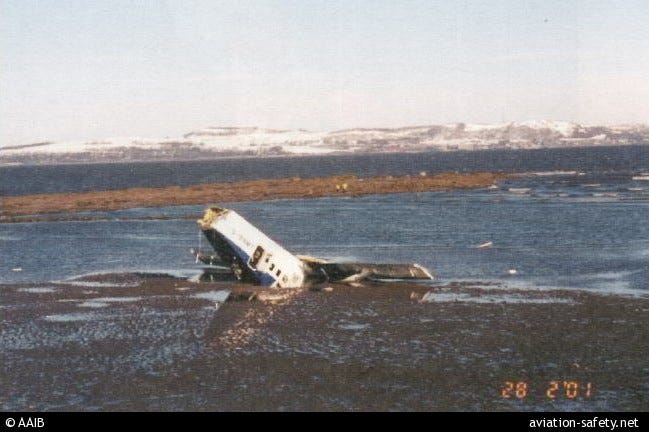
By introducing particles of snow and ice into an engine inlet during a wind tunnel test, investigators were able to show that snow could have built up in the top of the plenum chamber while the plane was parked facing into the wind during the snowstorm overnight. It was not practical for the simulation to go any farther than that, but based on the clues which did exist, the AAIB was able to come up with a probable sequence of events that fit the evidence. Specifically, they knew that the engine failures occurred as a direct result of the activation of the engine anti-ice vanes. This could not possibly have been a coincidence: according to the flight data recorder, the First Officer flipped the switches for the two sets of vanes exactly 0.40 seconds apart, and the engines each failed exactly 3.95 seconds later, again with a 0.40-second gap between them.
Investigators eventually concluded that the snow in the top of the plenum chamber probably turned to slush as it was heated by the engines, then slid down into the intake ducts, accumulating in front of the aft bypass vanes, where cool air flowing through the inlets prevented it from melting. When the bypass vanes opened, they pushed the piles of slush forward into the area which was already constricted by the forward vanes, fatally reducing airflow into both engines.
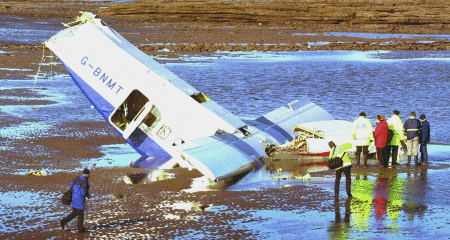
The AAIB also identified several ways in which the accident could have been prevented. The initiating factor was the lack of engine air intake bungs at Edinburgh Airport. This stemmed from Loganair’s policy of keeping the bungs at their various bases of operation rather than on board the airplanes themselves, where they could be retrieved in the event of an unplanned overnight stay at an outstation airport, such as that experienced by flight 670A. This policy showed that the airline was not aware of the importance of the bungs in preventing engine problems arising due to weather conditions while an airplane is parked. The AAIB was able to find a few other minor incidents of power loss during the takeoff roll involving one Short 360 and two de Havilland DHC-8s which appeared to have been caused by snow in the engines, thus underlining the potential danger. But these incidents were not well known in the industry, and Loganair was unaware that they had occurred.
The accident could also have been prevented if the pilots had turned on continuous ignition prior to takeoff. Normally the ignition system on a turbine engine shuts off automatically once the engine has spooled up, but in adverse weather conditions or when attempting a windmill restart of a failed engine, the pilots can set the ignition system to continuously introduce a spark into the combustion chamber, thereby relighting an engine which has flamed out or preventing a flame out due to the ingestion of large volumes of water. The manufacturer’s procedures called for the pilots to turn on continuous ignition if they expected to fly through heavy rain or hail, or if there was standing water or slush on the runway which could be thrown into the engines during takeoff. But the procedures in the Loganair operations manual available to the crew left out the suggestion to turn on continuous ignition if the runway was wet — the only one of the aforementioned conditions that was applicable to flight 670A. Thus the pilots had no apparent reason to turn the system on. If they had, it probably would have been able to automatically relight the engines as soon as the airflow pushed the slush back toward the bypass ducts, resulting in only a transient loss of power. Instead, the pilots found themselves in a situation where they needed to restart the engines manually, a process that would have taken considerably longer than the amount of time that was actually available.
Captain Mason therefore assessed the situation correctly when he decided to focus on finding a place to land rather than on restarting the engines. Unfortunately, the options available to him were all very bad. He did aim for the grass strip, the best possible landing site, but they simply didn’t have enough time to reach it. The water conditions were also unsuitable for a ditching, rendering the breakup of the plane inevitable despite Mason’s efforts to achieve the slowest possible airspeed and highest possible pitch angle on touchdown. He did all of this despite the fact that the ditching procedures were designed for a ditching with power on, and were mostly inapplicable to the situation he was actually facing. The pilots thus did everything they could; after that, only chance would decide whether they survived. Tragically, lady luck was not on their side that day.
In its final report on the crash, the AAIB issued several recommendations, including that the manufacturer inform all operators of the circumstances of the accident and the importance of fitting blanks over the engine air intakes when the plane is parked; that the Civil Aviation Authority spread awareness among pilots about the possibility of snow building up in hidden parts of aircraft engines; that the manufacturer develop a shorter engine relight procedure; that the Short 360’s auto-ignition system run all the time, or that pilots be required to turn it on before activating the engine anti-ice systems; and that the CAA check that all UK operators are providing the equipment needed for their crews to properly secure parked airplanes.
Following the publication of the report, Loganair lamented the fact that it had not been informed of the earlier incidents, and told the press that their tight-knit pilot cohort was still struggling with the sudden loss of two well-liked colleagues. Fortunately, the CAA took the AAIB’s recommendations seriously and distributed literature about the accident and its causes throughout the United Kingdom, ensuring that pilots are aware that snow can lead to a loss of engine power. As for the Short 360, it’s unclear whether any design changes were made, but in any case Loganair retired the type in 2004 after 21 years of service without experiencing any further incidents. A few dozen examples still fly today, however, including several which run cargo out of Milwaukee, Wisconsin. So far, nothing like the crash of Loganair flight 670A has happened again, and as long as these quirky flying sheds continue to ply the skies above us, we may hope that the right lessons have indeed been learned.
________________________________________________________________
Join the discussion of this article on Reddit!
Visit r/admiralcloudberg to read and discuss over 190 similar articles.
You can also support me on Patreon.
